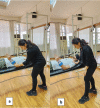Sensory function and somatosensorial system changes according to visual acuity and throwing techniques in goalball players: A cross-sectional study
- PMID: 38478545
- PMCID: PMC10936811
- DOI: 10.1371/journal.pone.0296948
Sensory function and somatosensorial system changes according to visual acuity and throwing techniques in goalball players: A cross-sectional study
Abstract
The somatosensory system is a complect sensory system that differentiates individual athletes. The aim of this study is to investigate the effect of visual acuity level on throwing technique, proprioceptive sense of the shoulder joint, light touch and two-point discrimination sense of the upper extremity, and sensory function (postural control and reaction time) in visually impaired goalball players. Goalball players who have different visual acuities B1(unable to perceive light or recognize its shape); B2 (has a visual field of less than 5 degrees and can recognize shapes); B3 (visual field greater than 5 degrees and less than 20 degrees) participated in the study. The sensorial system was evaluated with proprioceptive sense of the shoulder joint and sensory tests (light touch and two-point discrimination sense of the dominant hand.). Sensory function (postural control and reaction time) was evaluated with the flamingo balance test, functional reach test, and pro-agility test. The goalball players' throwing technique was questioned. Seventeen male players, those aged 20-30 (20.8±3.9 years) who have been professionally engaged in goalball for at least three years (58.7-37.8 months) participated. Shoulder internal rotation joint position sense and the flamingo balance test were found to be different in the group with B1 visual acuity than in the group with B3 visual acuity (p = 0.042* and 0.028 respectively). There was no difference between groups with B1-B2 visual acuity (p = 0.394 and p = 0.065) and between groups with B2-B3 visual acuity (p = 0.792 and p = 0.931). There was no difference in the groups in terms of sensory tests and reaction time (p> 0.05). In goalball, joint position sense is related to throwing techniques. Although there is a general acceptance that other sensory systems should work harder to compensate for the sense of vision, fear of falling, athlete's branch year, sports year, muscle strength, and general physical condition of the athlete may affect the measurements made, especially in the dynamic position.
Copyright: © 2024 Gökşen, İnce. This is an open access article distributed under the terms of the Creative Commons Attribution License, which permits unrestricted use, distribution, and reproduction in any medium, provided the original author and source are credited.
Conflict of interest statement
The authors have declared that no competing interests exist.
Similar articles
-
Electromyographic analysis of the traditional and spin throwing techniques for goalball games related to ball velocity for selected upper extremity muscles.BMC Sports Sci Med Rehabil. 2024 May 9;16(1):99. doi: 10.1186/s13102-024-00887-5. BMC Sports Sci Med Rehabil. 2024. PMID: 38725049 Free PMC article.
-
Handball players have superior shoulder proprioception: a prospective controlled study.J Shoulder Elbow Surg. 2024 Jan;33(1):e1-e12. doi: 10.1016/j.jse.2023.07.028. Epub 2023 Aug 23. J Shoulder Elbow Surg. 2024. PMID: 37625691
-
Throwing performance in water polo is related to in-water shoulder proprioception.J Sports Sci. 2019 Nov;37(22):2588-2595. doi: 10.1080/02640414.2019.1648987. Epub 2019 Jul 29. J Sports Sci. 2019. PMID: 31352872
-
Humeral Retroversion and Capsule Thickening in the Overhead Throwing Athlete: A Systematic Review.Arthroscopy. 2018 Apr;34(4):1308-1318. doi: 10.1016/j.arthro.2017.10.049. Epub 2018 Jan 17. Arthroscopy. 2018. PMID: 29373297
-
Rehabilitation of the Overhead Throwing Athlete: There Is More to It Than Just External Rotation/Internal Rotation Strengthening.PM R. 2016 Mar;8(3 Suppl):S78-90. doi: 10.1016/j.pmrj.2015.12.005. PM R. 2016. PMID: 26972270 Review.
References
-
- Bednarczuk G, Molik B, Morgulec-Adamowicz N, Kosmol A, Wiszomirska I, Rutkowska I, et al.. Static balance of visually impaired paralympic goalball players. International Journal of Sports Science & Coaching. 2017;12(5):611–7. 10.1177/1747954117727791. - DOI
-
- Kimyon B, Ince G. The Comparison of Physical Fitness, Anthropometric Characteristics, and Visual Acuity of Goalball Players with Their Right Shot Performance. Journal of Visual Impairment & Blindness. 2020;114(6):516–30. 10.1177/0145482X20972501. - DOI
-
- Santos CdN, Carvalho TLd, Felício LR, Mainenti MRM, Vigário PdS. Postural control in athletes with different degrees of visual impairment. Journal of Physical Education. 2018;29. 10.4025/jphyseduc.v29i1.2936. - DOI
MeSH terms
LinkOut - more resources
Full Text Sources





